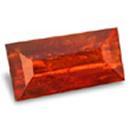|
|
|
|
Click on a letter above to view the list of gems. |
|
|
|
|
|
Monazite |
|
| Chemistry: (Ce,La,Nd,Th)PO4 [Cerium Lanthanum Neodymium Thorium Phosphate] | |
| Discovered
in 1829;
IMA
status: Valid (pre-IMA; Grandfathered). | ||
|
| ||
|
Classification |
|
|
| |
|
Phosphates | |
|
7/A.15-20 | |
|
|
8 : PHOSPHATES, ARSENATES, VANADATES |
|
Related to: |
Monazite Group: Monazite-(La), Monazite-(Ce), Monazite-(Nd), Monazite-(Sm), Cheralite-(Ce), Brabantite |
|
|
|
|
Crystal Data |
|
|
|
|
|
Crystals typically tabular on [100], may be prismatic, equant or wedge-shaped, to 27 cm; granular, massive. |
|
|
Common, [100] as twin and composition plane, as contact twins. |
|
|
|
|
|
Physical Properties |
|
|
|
|
|
[100] Distinct, [010] Poor; parting on [001] or [111] |
|
|
Conchoidal to Irregular/Uneven |
|
|
Brittle |
|
|
5.0 - 5.5 |
|
|
4.98 - 5.43 (g/cm3) |
|
|
Dull brown cathodluminescence |
|
|
If rich in Thorium: Weak; GRapi = 91,584.19 (Gamma Ray American Petroleum Institute Units) |
|
|
Other: |
Metamict if rich in Thorium. Paramagnetic |
|
|
|
|
Optical Properties |
|
|
|
|
|
Reddish Brown, Brown, pale Yellow, Pink, Grayish White |
|
|
Translucent to Opaque |
|
|
Vitreous to Sub-Adamantine, Resinous, Waxy |
|
|
1.770 - 1.860 Biaxial (+) |
|
|
0.053 - 0.067 |
|
|
r < v or r > v, weak, horizontal |
|
|
Weak; Faint to imperceptible. In pale yellows. |
|
|
|
|
|
Occurances |
|
|
|
|
|
Geological Setting: |
An accessory mineral in granites, syenites, and their pegmatites; in carbonatites and volcanoclastic rocks; in fissure veins and high-grade metamorphic rocks; commonly detrital in river and beach sands; rarely authigenic in shales and intense weathering zones. |
|
Common Associations: |
Allanite, Columbite, Thorite, Titanite, Wolframite, Xenotime, Zircon (pegmatites and Alpine fissures); Cerianite, Churchite, Florencite, Rhabdophane (Mt. Weld, Australia). |
|
Type Locality: |
Ilmen Natural Reserve, Ilmen Mts, Chelyabinsk Oblast', Southern Urals, Urals Region, Russia |
|
Year Discovered: |
1829 |
|
View mineral photos: | |
|
|
|
|
More Information |
|
|
|
|
|
| |
|
|
|
|
Monazite is a primary ore of several rare earth elements (REE) such as Thorium, Cerium and Lanthanum. Thorium is highly radioactive. Since Monazite is radioactive it is often metamict. Metamict is the condition when the radiation destroys the crystal lattice completely while leaving the outward appearance of the crystal unchanged. Increased metamictation will increase the transformation of the mineral's fracture from irregular/uneven to conchoidal. Monazite
is widely distributed but gem quality crystals are quite
rare. The main sources of gems are Minas Gerais, Brazil
and Tsumeb, Namibia. |
|
|
We
have not photographed our Monazite
gems. Please
check back soon. |
